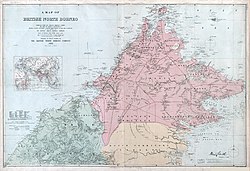
Back شمال بورنيو Arabic Borneo del Nord Catalan Britisk Nordborneo Danish Nord-Borneo German Nord-Borneo Esperanto Borneo Septentrional británico Spanish شمال بورنئو Persian Pohjois-Borneo Finnish Bornéo du Nord French Borneo Utara Britania ID
North Borneo Borneo Utara | |
|---|---|
| 1881–1942 1945–1946 | |
| Motto: Latin: Pergo et Perago[1] (I persevere and I achieve)[1] | |
| Anthem: God Save the Queen (1881–1901) God Save the King (1901–1942; 1945–1946) | |
 Map of North Borneo, 1903 | |
| Status | Protectorate of the United Kingdom |
| Capital | Kudat (1881–1884); Sandakan (1884–1945); Jesselton (1946) |
| Common languages | English, Kadazan-Dusun, Bajau, Murut, Lundayeh, Sabah Malay, Chinese etc. |
| Government | Chartered company, Protectorate |
| Monarch | |
• 1881-1901 | Victoria (first) |
• 1936-1942, 1945-1946 | George VI (last) |
| Governor | |
• 1881–1887 | William Hood Treacher (first) |
• 1937–1946 | Charles Robert Smith (last) |
| Historical era | New Imperialism |
• North Borneo Provisional Association Ltd | 26 August 1881 |
• Granted royal charter | 1 November 1881 |
| May 1882 | |
• Protectorate | 12 May 1888 |
| 2 January 1942 | |
| 10 June 1945 | |
• Ceded to the Crown colony | 15 July 1946 |
| Currency | North Borneo dollar |
| Today part of | Malaysia |
North Borneo (usually known as British North Borneo, also known as the State of North Borneo)[2] was a British protectorate in the northern part of the island of Borneo, which is present day Sabah. The territory of North Borneo was originally established by concessions of the Sultanates of Brunei and Sulu in 1877 and 1878 to a German-born representative of Austria-Hungary, a businessman and diplomat, Gustav Overbeck.
Overbeck had recently purchased a small tract of land in the western coast of Borneo in 1876 from American merchant Joseph William Torrey, who had promoted the territory in Hong Kong since 1866. Overbeck then transferred all his rights to Alfred Dent before withdrawing in 1879. In 1881, Dent established the North Borneo Provisional Association Ltd to manage the territory, which was granted a royal charter in the same year. The following year, the Provisional Association was replaced by the North Borneo Chartered Company. The granting of a royal charter worried both the neighbouring Spanish and Dutch authorities; as a result, the Spanish began to stake their claim of northern Borneo. A protocol known as the Madrid Protocol was signed in 1885 to recognise Spanish presence in the Philippine archipelago, in return establishing the definite border of Spanish influence beyond northern Borneo. To avoid further claims from other European powers, North Borneo was made a British protectorate in 1888.
North Borneo produced timber for export; along with agriculture this industry remained the main economic resource for the British in Borneo. As the population was too small to effectively serve the economy, the British sponsored various migration schemes for Chinese workers from Hong Kong and China to work in the European plantations, and for Japanese immigrants to participate in the economic activities of North Borneo. The starting of World War II with the arrival of Japanese forces however brought an end to protectorate administration, with the territory placed under a military administration and then designated as a crown colony.
- ^ a b Great Britain. Colonial Office 1956, p. 6.
- ^ Great Britain. Foreign Office 1888, p. 238.
© MMXXIII Rich X Search. We shall prevail. All rights reserved. Rich X Search

